Shield under the bath - a stylish and effective solution
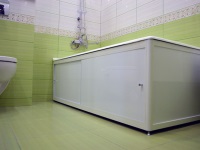
The whole is made of little things, and the image of the bathroom is made of seemingly small interior details. And sometimes such annoying little things like water pipes or a bucket with a mop, peeking out from under the tub, can completely spoil the impression and reduce to zero all your efforts to impose "glamour and shine" in the bathroom.
Such a useful thing as a screen under the bath can be a solution to this problem. If you will make an effort and show some imagination, it will not only hide everything that is necessary from prying eyes, but also will become an independent element of the bathroom interior.
Types of screens
You can buy a screen under the bathtub in any construction store. They come in two kinds of construction - solid and sliding.But the material used for manufacture is different.
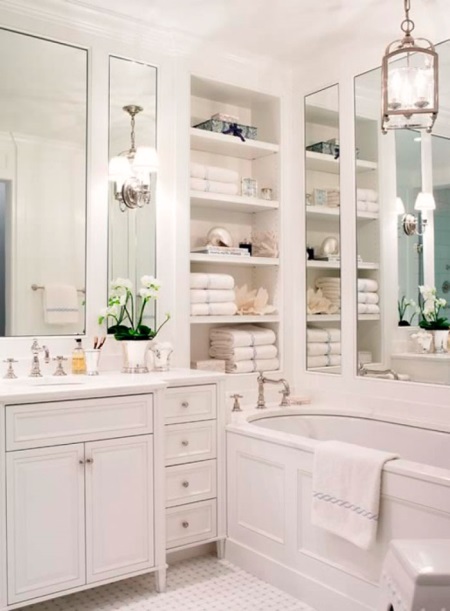
To date, most frequently encountered screens of the following materials:
- gypsum board
- gasket board
- ceramic tile
- mirror
- perspex
- acrylic
- PVC panels
- MDF.
Solid
A solid screen under the bathtub is the simplest and most obvious solution. Usually it is tiled with the same tiles as the entire bathroom, so that such a screen fits perfectly into the bathroom interior.
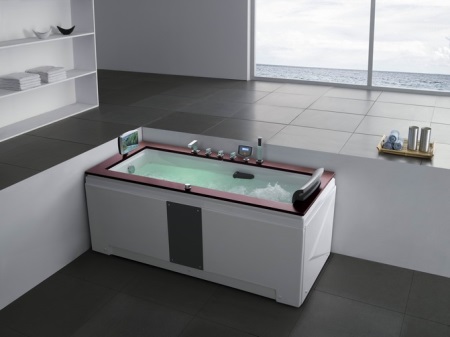
The disadvantage of a solid screen is that it provides no access to the water pipes, nor the possibility of storing various tools and household chemicals under the tub. If you need to repair or replace plumbing, then such a screen will have to be disassembled.
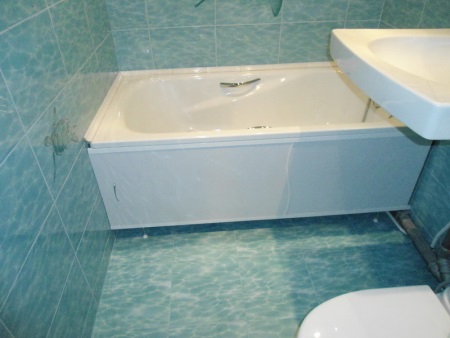
Sliding
Sliding screen is much more practical than a solid screen, although it may not look as aesthetically pleasing.
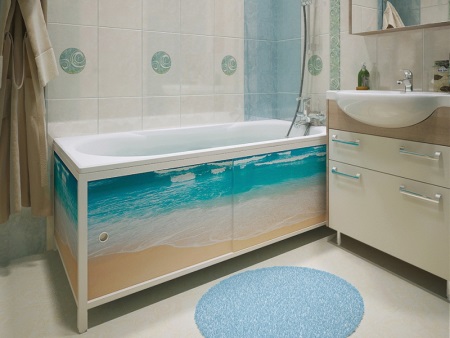
Made of plasterboard
Gypsum board is the most affordable material for making a screen under the bath. It is inexpensive, lightweight and it is easy to make the necessary structure. Drywall is used to make solid screens, which are then tiled.
Plasterboard screen with their own hands
You can make and install such a screen yourself.
The plasterboard screen is installed on a frame made of timber, so first it is necessary to construct it. For this you will need a 4x4 cm bar, fasteners and a metal angle.
First, take all the necessary measurements and mark the walls and the floor, then draw lines parallel to the marking, but offset inside the bathtub by 2.5 cm
Then divide the skirting board into slats. You'll need the following strips:
- The four slats that connect the corners of the bathtub to the floor.
- Two slats equal to the inner bathtub width minus 0.8 cm
- Two slats, equal to the inner line of the bathtub length minus 1.2 cm
- If the bath is too long, it is better to prepare two or three slats, which will serve as additional supports.
Steps for making the screen for the bath:
- Place the vertical slats on the outer corners of the tub According to the markings and fix the horizontal slats above and below between them. You will need to make two of these constructions for the narrow sides of the tub and one for the wide.
- Drill two holes in the slats that will be adjacent to the wall in advance and fasten them to the wall. Using screws, fasten all parts of the structure to each other. To make the frame more stable, you can also attach the bottom laths to the floor.
- Once the frame is ready, you can begin to make the screen itself from plasterboard. You will need a sheet of moisture-resistant gypsum board, a special metal latch and hinges.
- After taking the necessary measurements, cut out the necessary parts from the drywall, Leaving an overlap of 0.56 cm in width. Then you will need to provide a door that will provide access to the "insides" of the bath. The door can be in a short or long part of the screen, depending on the location of the bath. Once you have determined the location, cut a hole in the desired part and install the door, using the hinges and latch.
- After that, secure the drywall strips to the frame with screws. Don't forget to check the stability of the entire structure.
The plasterboard screen is ready!
The method of making the screen we described above is only suitable for standard rectangular bathtubs.
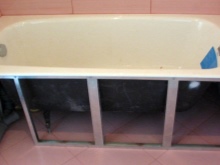
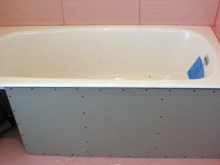
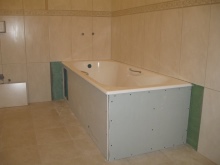
Curved screen
If you are the lucky owner of a rounded bath, then you will have to install a special, curvilinear screen.
For a curvilinear screen, you will also need a frame. It is assembled from a special profile for drywall. Such a profile can take any shape, you only need to make the necessary cuts on it.
- Prepare two such profiles, repeating the contours of the bath - for the upper and for the bottom of the frame - and fix them with screws, indenting from the edge of the bath at a distance equal to the thickness of the plasterboard (if the framework is supposed to finish with tiles, add the thickness of the tiles and glue).
- Next, attach vertical slats to the corners of the bath.
- After the frame is ready, moisten the sheets of drywall with water and, gradually giving it the desired shape, fasten it to the frame.
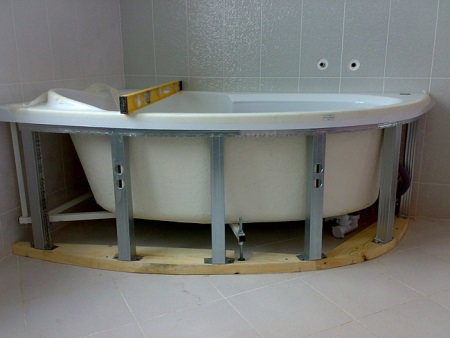
A gutter board screen
Gapboards are building blocks, interlocking with each other on the principle of groove connection.
Shield under the bath with his hands
Before you begin to build a gasketed screen, treat the place of installation with primer.
Using a plumb line, draw a marking on the floor, leaving 0.5 cm to the side of the bath. After that, you can begin laying the screen of plates. Slabs are connected to each other with grooves and ridges, and between them is placed binding mortar (it can be tile adhesive or gypsum plaster).
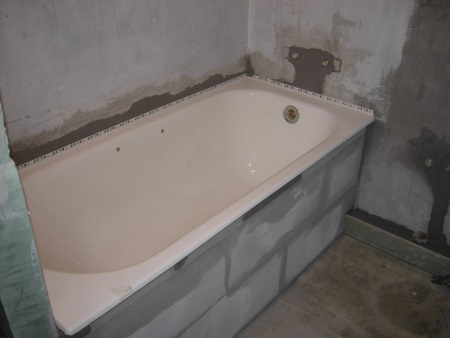
Such a screen does not look very aesthetically pleasing, so on top it is better to perform tiling - it is under it we did a half-centimeter indent at the initial stage of installation.
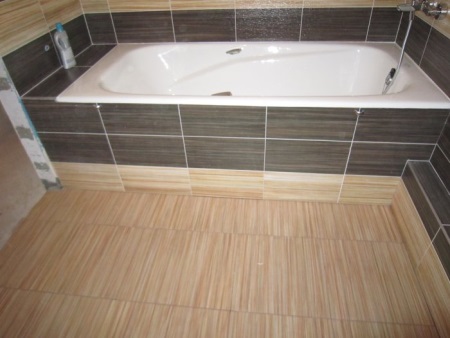
Of ceramic tiles
You see ceramic tile screens in bathrooms quite often. This is the most affordable way to ennoble the space under the bath, to give it a neat and beautiful appearance.
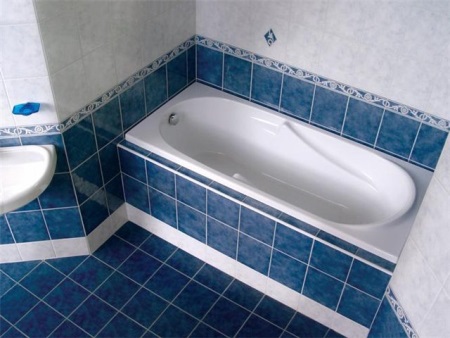
Ceramic tiles are usually finished with screens under the bath, made of drywall or gypsum tiles. Ceramic tile installation is very simple.
Start laying tiles from the upper left corner. Apply tile adhesive to each tile, or apply a few drops of liquid nails to it. Use special fasteners to even out the gaps between the tiles. If a door is provided, you can also put tiles on it. When the work is finished, treat the joints with grout.
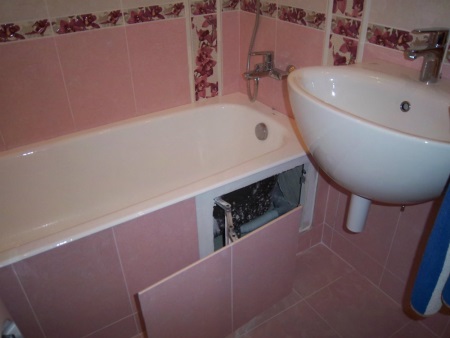
Sliding screen
Sliding screen under the bathtub allows you to solve the problems associated with storing various necessary and not so necessary things left over from repairs, household chemicals, buckets, basins and much more. In addition, it allows you at any time and without unnecessary effort to engage in the repair of the bath, because in order to get access to the pipes, you will not need to dismantle anything. For especially clean mistresses, sliding screen will also be a real godsend, because it is easy and simple to wash the floor under the tub and sweep away accumulated garbage.
You can install such a screen yourself and very quickly. In stores there is a large selection of models for bathtubs of standard sizes, and the height of the sliding screen can be adjusted independently.
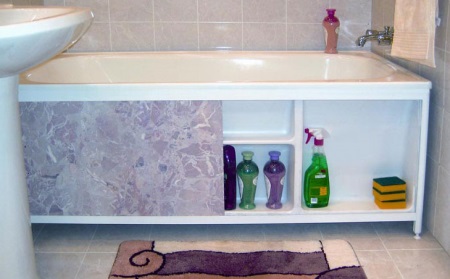
Most often, sliding screens under the bath are made of plastic panels, but there are other options.
Made of Plexiglas
The sliding screen under the bath made of organic glass, or plexiglass is a beautiful and modern solution. This material is excellent for the bathroom. Its only disadvantage is insufficient strength, but this disadvantage is more than offset by the advantages of the material.
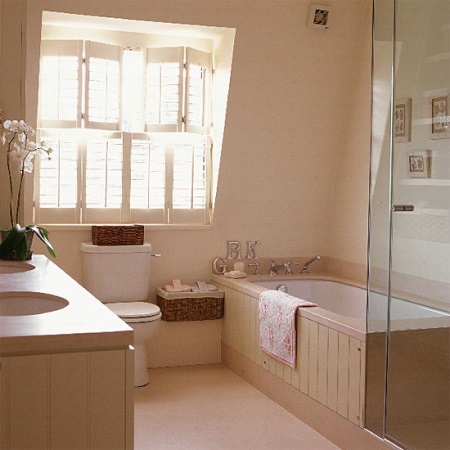
Plexiglas screens are easy to care for, resistant to moisture and durable. In addition, this material has a huge variety of colors and textures. You can choose a screen based on the color scheme of your bathroom. It can be matte, transparent and even mirror.
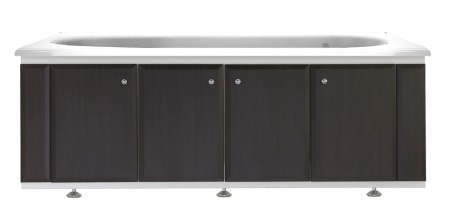
Mirror
The mirror is an essential element of the interior of any bathroom. In addition to its direct purpose, it can visually increase the space, as well as provide an additional play of light. The mirror elements in the bathroom can be placed in the most unexpected places, for example, under the bathtub.
The screen under the bath, made of real mirror - a thing fragile and impractical, so manufacturers offer screens of Plexiglas with a mirror coating.
A mirror screen is sure to become a highlight of your bathroom interior and will not cause any trouble, because it is made of durable moisture-resistant material, which is also very easy to clean.

Acrylic
Acrylic bathtubs are often sold with a screen. The screens that come with the bathtub are usually made of plastic panels with acrylic coating. These screens are made to fit a specific model of bathtub, so a universal acrylic screen that can be installed under any bathtub is quite difficult to find.
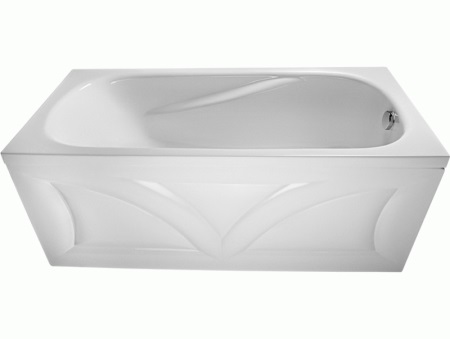
Acrylic screens are very lightweight, inexpensive, look neat and last a long time. But such a screen can only be installed under an acrylic bath, as it has a specific mechanism for fixing.
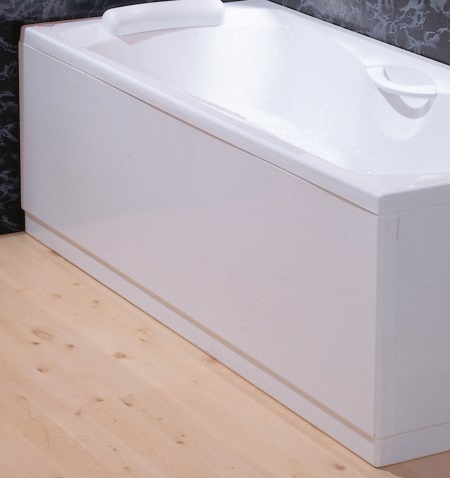
Of PVC panels
PVC panels as a screen under the bath will help to become an independent element of the interior of your bathroom. You can choose a color and pattern from those available in the store or come up with your own design.
The color screens of PVC panels look unusual, and it is very easy to open-close them. Moreover, if you do not expose it to strong mechanical stress, this screen can serve for decades.
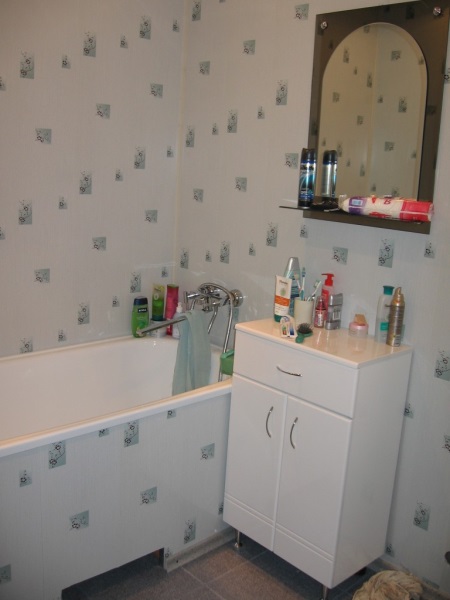
Made of MDF
Mimicking the natural wood grain, the MDF bathtub screens are a great fit in a classic bathroom or a country or eco style bathroom.They will fit in the interior of a classic bathroom, or in a bathroom in the country or eco style.. The large variety of colors allows you to easily match the screen with the color of the furniture in the bathroom. Stores have a large selection of MDF screens of different designs - solid and sliding. Despite the low cost, the MDF screen looks expensive and noble.
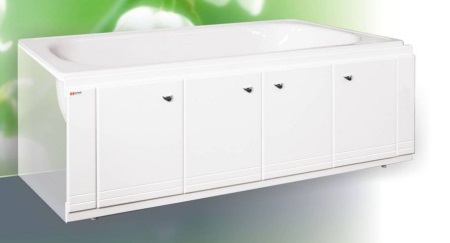
When buying such a screen should be aware that the models on sale, suitable only for bathrooms of standard shapes and sizes. In addition, MDF - moisture-resistant material, so after three to four years of operation the screen will swell and deform. Therefore, buy an MDF screen that will be specially treated with a moisture-protective coating.
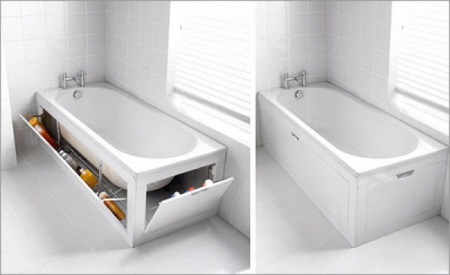
Shape of the screen
You can make a screen under the bathtub, buy it in a store or trust a professional craftsman to make it. All these options have their pros and cons, and in any case, first you have to decide on the form of the future screen.
Bath screens can be of three types:
- In the form of a blank wall - does not assume any open niches, it completely covers the space under the bathtub.
- With a notch for the feet at floor level - the notch will give you the opportunity to stand up close to the tub. So it will be much more convenient to wash the tub and bathe the children in it.
- Tilted at an angle - also allows you to get closer to the tub and, in addition, protects the bathroom floor from splashing water.
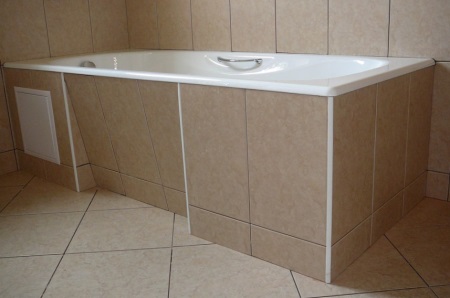
Where to buy or order a bath screen
So, you already know exactly what screen you want to install under the bathtub. You have decided on the design, material, shape and even color. The only thing left is to buy the screen.
You can buy a screen in a store. In construction hypermarkets there are a huge number of models of screens under the bath. There you can talk to professional consultants, compare prices, as well as determine the quality and durability of the chosen model directly on the spot (good thing nobody forbids touching goods in construction stores). The disadvantage of this method is that you risk overpaying, as sellers are often very strong "twist" prices.
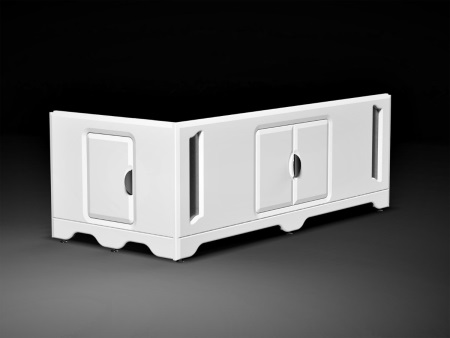
You can also make a screen under the bath by yourself. So you will lose less money and can fabricate a design that best meets your ideas about comfort and beauty. However, the purchase of necessary materials, and the process of manufacturing the screen will make you spend a lot of time and effort.
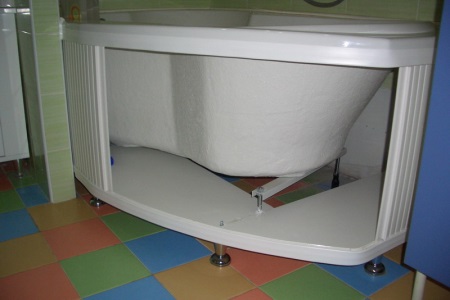
And finally, you can order a screen under the bath in the online store. The advantage of this method is that you can make a purchase without leaving home, and order delivery at a convenient time for you. In addition, you can save a certain amount of money, because it is usually much more profitable to shop online than in stores. The disadvantage is that when choosing a screen, you can be guided only by the description and photos of the product, not being able to touch the product and assess its quality.
Ceramic tiles are usually finished screens under the bath, made of plasterboard or gypsum tiles. Laying ceramic tiles is very simple.
Start laying tiles from the upper left corner. Apply tile adhesive to each tile, or apply a few drops of liquid nails to it. Use special fasteners to even out the gaps between the tiles. If a door is provided, you can also put tiles on it. When the work is finished, treat the seams with grout.
You can avoid unpleasant surprises by studying all the characteristics of the screen in a construction store and ordering it online. Then you will be confident in the quality of the selected product.
Useful tips
Special containers with many compartments for storing small things will help to organize the order under the bath. In such boxes it is convenient to store various household items. In hardware stores you can even find containers on wheels, which you can move under the bath without the slightest effort.

Household chemicals, brushes and sponges can be stored in closed shelves attached to one of the sections of the sliding screen on the inside. So everything you need for cleaning in the bathroom will always be at your fingertips.
We advise you to read our article on How to make a screen for the bath with your own hands.





Cool! put a bunch of jars, detergents, shampoos using the bathroom screen. Awesome solution.